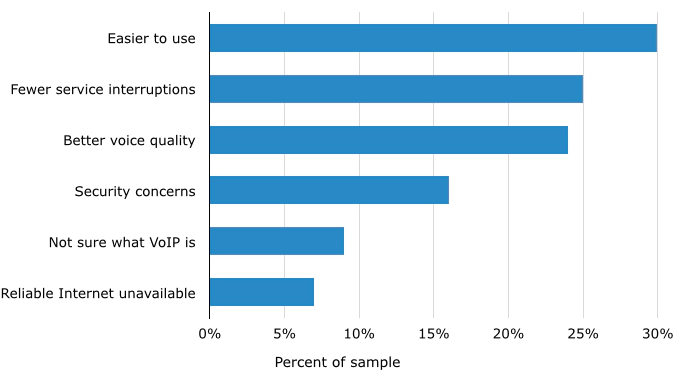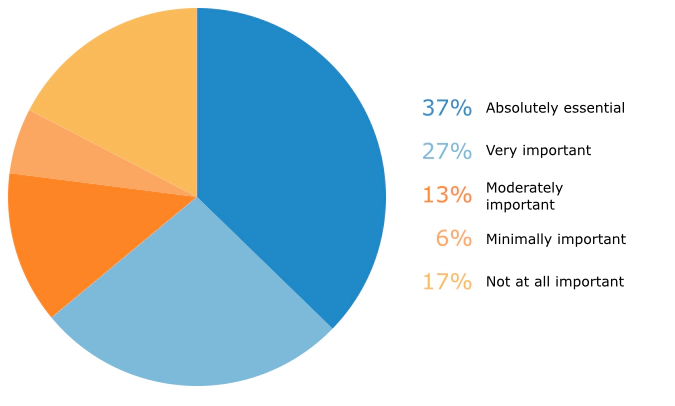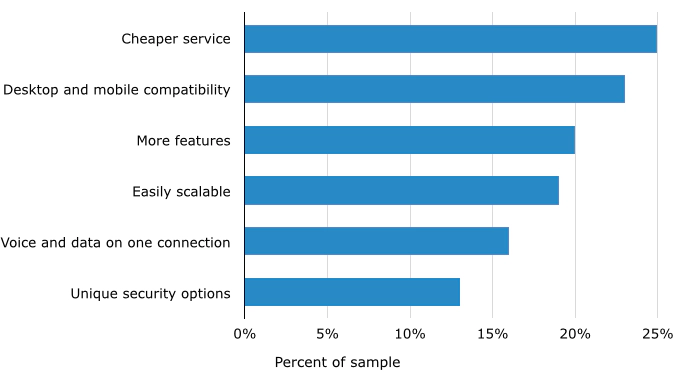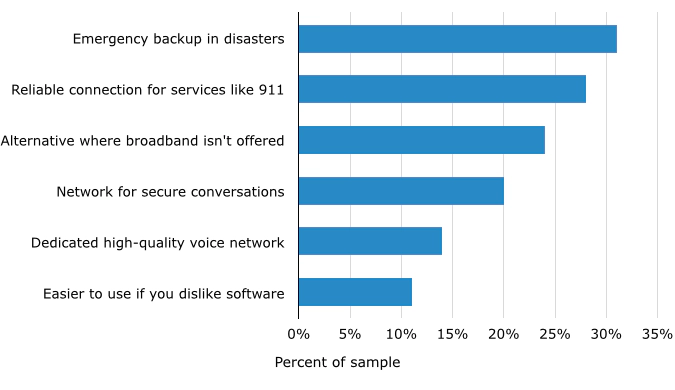PSTN vs VoIP: The Debate
In recent times there has been a significant uptake of VoIP services by businesses, which has led some to proclaim that the rise of VoIP has led to the death of the PSTN (Public Switched Telephone Network). But in certain countries, the jury is still out and the debate is still ongoing. But why you may ask, especially when the benefits of VoIP are plain to see and well documented. You need only browse through the other pages on this blog and hundreds of others like it to find heaps of info on the benefits of VoIP. So why are businesses still wary of making the switch? If you or your business falls into this category, then keep reading and you will quickly discover you are not alone, but you will also find out that perhaps making the switch is not such a blind leap of faith as you once thought but rather a very sensible business decision.
VoIP and telecoms review website Software Advice recently contacted me regarding a research study they had undertaken in the wake of the Federal Communications Commissions’ (FCC) report into the state of the telecoms industry competition in the USA, which uncovered some interesting findings, none more so than the fact in terms of VoIP adoption by businesses in the USA, only 15.4% were operating VoIP systems as of June 2013. Compiled by Daniel Harris, a telecoms researcher at Software Advice, the report highlights responses from 161 decision makers at companies in the US who still utilise the PSTN and outlines why they do so as well as which VoIP benefits would entice them to make the switch.
What are the sore points holding them back?
According to the research, the biggest factor (30% of respondents) that is holding organisations back and preventing them from making the switch to VoIP is that they consider the PSTN easier to use. It’s a fair point, but could it not be that they are just more familiar with their PSTN systems and we all know how people dislike change. On the other hand, consider for a moment, that just like most technologies (including VoIP), PSTN systems require specialist technicians to maintain and service them, but given that most providers have already jumped on the VoIP bandwagon, they are increasingly harder to find, as are spare parts. Let’s take Deutsche Telekom in Germany for example, they aim to have an “All IP” fibre optic network by 2018 across their German & European Networks and then there’s Macedonia, who are already “All IP which all means that PSTN engineers and hardware will become increasingly difficult to come by.
 PSTN vs VoIP
PSTN vs VoIP
Then there is the fact that VoIP systems are designed to be user-friendly. Deploying a VoIP system means that you will no longer need service technicians to come in and maintain your systems as it can all be done by your in-house IT staff, or remotely by your service provider. Moreover, when one considers that IP PBXs have been around for over a decade now, a whole industry has developed around the concept - VoIP systems are no longer the complex end-user systems they once were.
Another interesting result that arose from the survey is that 25% of respondents cling to their PSTN Connections in order to avoid service interruptions Once again this is a valid argument as it is true that should the power fail, VoIP may lose functionality, but there are ways around this particular VoIP drawback, such as battery backup solutions (USP - uninterruptible power supplies). Other alternatives include deploying T1 lines for ISDN connectivity as another power failure back up solution. Should you be considering the switch but this area is a particular sore point for you, check with the VoIP system providers you have been looking into as to whether they offer such solutions.
Third on the list, as shown above, is that companies are holding onto their PSTN connections as they believe it provides better voice quality. That may well once have been true, as broadband connections offered insufficient bandwidth and corporate IT networks struggled to keep up with the increased volume of traffic and how to identify priority traffic such as voice data. Now, however, with advances in technology and increased availability of higher speed and quality internet it can be said that VoIP systems provide users with the same voice quality, if not better when one considers advancements in High Definition audio codecs. This does, of course, all mean that when implementing a VoIP system, companies may well be confronted with more upfront costs in terms of sourcing newer hardware, the better internet connections etc, but their ongoing costs will decrease rapidly and they will have a system that offers increased flexibility in terms of the number of lines available, increased feature sets and functionality.
Finally, on the table above, it is good to see that less and less companies are hesitant to make the switch because they do not know what VoIP is and how it works, which at least means that they are informing themselves regarding IP phone systems even if they are not quite ready to make the transition. Even more pleasing to read is that the availability of reliable internet connections is becoming less and less of a problem, which will also go a long way to overcoming the issue of PSTN vs VoIP quality.
Another sore spot for PSTN subscribers is ensuring uninterrupted services. The table below illustrates that 37 % consider uninterrupted service an absolute must have, while 27% consider the issue as very important and is, therefore, holding them back from switching their telephony services.
 PSTN vs VoIP Important of Uninterrupted Service
PSTN vs VoIP Important of Uninterrupted Service
However, there are, as is usual with VoIP, counter-arguments here too. For example, if you operate a call centre, it is, of course, an absolute must that your agents can continually make and receive calls. Voice over IP High Availability (HA) solutions ensure exactly this as do hybrid IP PBXs that connect to both VoIP services as well as the PSTN. If this is a major concern, which I can imagine it is for many business models based around call volumes, why not implement a HA solution to protect your telephony services against server failure to ensure you gain maximum benefit from utilising your SIP trunk whilst simultaneously ensuring that your HA solution is built around a hybrid PBX meaning should your SIP trunk fail, you can still utilise the PSTN?
What actually attracts PSTN users to VoIP
In order to truly understand the survey’s findings, it is first important to understand the two types of PSTN users - analogue and digital. Analogue services operate using the oldest telephony services around, often referred to as POTS (Plain Old Telephone Service). Then we have digital services which uses technology referred to as ISDN which transmits multimedia data over the PSTN. So of course, while the research lumps these two user types into one PSTN user category, their understanding of VoIP will differ.
Unsurprisingly, however, cost came up top of the list of reasons for making the switch to VoIP, with 25 % of the decision makers surveyed responding that the cheaper service made VoIP an attractive option. This further highlights want I mentioned earlier, that companies are most definitely informing themselves regarding the benefits of VoIP. It is important to note, that of those responding that they would be willing to consider VoIP solutions because of the cost savings, 35% where ISDN Users and 21% POTS users, which clearly demonstrates that people with more modern technology are also more likely to explore new options.
 PSTN vs VoIP: Attractions of VoIP
PSTN vs VoIP: Attractions of VoIP
Of more interest, is perhaps that desktop and mobile compatibility comes in at number two on the list, with approximately 23% stating that the out of the box compatibility offered by most VoIP solutions was another top benefit. This perhaps should not be so surprising, when one considers the mobile mad world we live in and is quite understandable when one considers that the PSTN simply cannot cope with mobile integration. To quote Software Advice, who explain the reasoning behind this rather effectively, “Whereas the roots of the PSTN pre-date our mobile-centric society by more than a century, mobile devices and IP networks have matured together”.
Another indicator that companies are increasingly looking towards VoIP solutions, is that 20% of the respondents stated that they find the increased number of available features as an attractor to making the switch. This is hardly surprising when we consider the features like presence information across multiple devices and locations, which are available to VoIP users but are simply not an option to PSTN users. Another aspect of VoIP that draws PSTN users, (19%) towards implementing VoIP solutions is how scalable Voice over IP systems can be, for example not having to add additional trunk lines in order to accommodate new members of staff.
So what is the future for the PSTN?
Software Advice then took their research further by posing the question of what role those questioned see the PSTN playing in an IP dominated IT ecosystem. It is most certainly an interesting question that threw up some very interesting answers.
 PSTN vs VoIP: PSTN Future
PSTN vs VoIP: PSTN Future
The research highlights many areas where the PSTN when combined with VoIP services, may still have a role to play. At the top of the list was utilising the PSTN as a backup in emergency disaster scenarios. Somewhat ironically, this is also one of the “hidden” benefits of implementing VoIP solutions, as should there be any form or natural disaster, VoIP solutions also enable employees to work from home should they not be able to make the daily commute due to severe weather or other scenarios. But it is also a consideration that should be taken into account when choosing a voice over IP system. Most IP PBX providers offer systems that can integrate the PSTN as part of a solution, so this may well be the route to go down especially if this is one of your major concerns.
Another justified concern is the connection to emergency services (or lack thereof). It is common practice throughout the world that callers to emergency numbers (999, 911, 112 or whatever it may be) can be accurately located. This becomes difficult when the call is transmitted over the internet. Ofcom in the UK and the FCC in the US have both made rulings that users must be able to make emergency calls using their VoIP services, but sadly in some countries, this is still not happening. The good news, however, is that many VoIP systems and providers do allow your location data to be transmitted when making emergency calls and systems go a step further by ensuring that any phone connected to the system, no matter whether a user is logged in or not, can be used to make emergency calls. Our advice here is when choosing your VoIP solution; make sure that your solutions providers offer such functionality.
VoIP a leap of faith or sensible business?
As you can clearly see, there are numerous arguments for and against on both sides of the PSTN vs VoIP argument, which need to be carefully considered whilst making the decision to switch your phone systems. As always, the key here is to do your own research and analysis in order to uncover the best solution to match your needs. Bear in mind, however, that VoIP is here to stay and you can understand why with all the cost-saving benefits combined with the increased availability of features and functions as well as the flexibility and scalability voice over IP solutions provide.
It is also worth considering that as more and more Telecom carriers move towards offering “All IP” services, making the switch to VoIP services is perhaps much more of a sensible business decision as opposed to a blind leap of faith.
If you are considering switching or upgrading your telephony services to VoIP or would like more information regarding pascom, then give the pascom team a call on +49 991 29691 0 to discuss your requirements and get started within minutes using our free hosted business VoIP phone system edition.